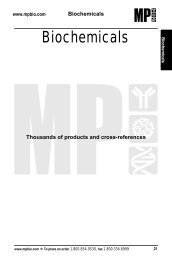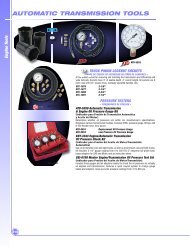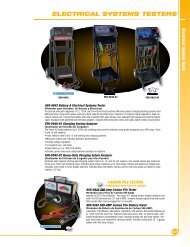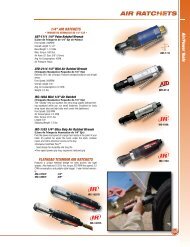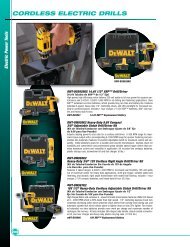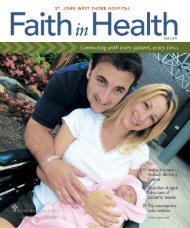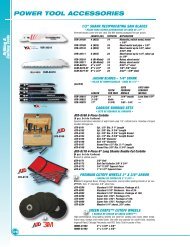INSIDE
INSIDE
INSIDE
Create successful ePaper yourself
Turn your PDF publications into a flip-book with our unique Google optimized e-Paper software.
continued from page 17<br />
health care services. It does not cover<br />
everything, nor does it cover the total<br />
cost for many of the covered services or<br />
medical supplies. Provided an employee<br />
or spouse has 40 or more quarters of<br />
Medicare-covered employment, there is<br />
no cost associated with Part A.<br />
Q: What is Medicare Part B?<br />
A: A medical insurance provided by the<br />
federal government that covers<br />
Medicare eligible physician services,<br />
outpatient services, certain home<br />
health services and durable medical<br />
equipment. Though many services and<br />
products are covered, Part B is not a 100<br />
percent insurance coverage plan. It<br />
costs $96.40 per month this year,<br />
provided your current income does not<br />
exceed $85,000 (single) or $170,000<br />
(married couple).<br />
Q: If I’m still offering employees<br />
insurance, should they take<br />
Medicare or not?<br />
A: COSE suggests employees turning 65<br />
enroll in Medicare Part A and Part B. If<br />
they do not receive a packet, they<br />
should contact Medicare directly.<br />
If your company has fewer than 20<br />
employees, Medicare is primary. This<br />
means Medicare pays claims first and<br />
the company’s insurance pays<br />
second. If an employee opts out of<br />
Medicare Part B, he or she may incur<br />
large out-of-pocket expenses since they<br />
are now responsible for the amount<br />
Medicare Part B would have paid.<br />
If the company has more than 20<br />
employees, the company insurance<br />
pays first and Medicare pays second.<br />
Q: Do employees need insurance in<br />
conjunction with Medicare?<br />
A: It’s not necessary, but secondary<br />
insurance will help minimize out-ofpocket<br />
expenses. Remember, Medicare<br />
does not cover everything, nor does it<br />
cover the total cost for many of the<br />
covered services or medical supplies.<br />
Q: Do employees have to notify<br />
Medical Mutual of Ohio when they<br />
are turning 65?<br />
A: Yes, employees should call Medical<br />
Mutual of Ohio’s customer service<br />
department when they receive their<br />
Medicare packet.<br />
Q: Will employee coverage remain<br />
the same if enrolled in Medicare<br />
and company insurance plan?<br />
A: As the employer, you need to make a<br />
plan selection for active employees<br />
turning 65. Your choices include<br />
Medifil and Medifil without Rx, which<br />
will change your employee’s coverage.<br />
And Medicare Carve Out, which, in<br />
most cases, will keep an employee’s<br />
coverage the same.<br />
Q: What Is Medicare Part D?<br />
A: Medicare Part D is a stand-alone<br />
prescription drug benefits plan<br />
available to all individuals turning 65<br />
years of age.<br />
Q: Do employees need to elect a<br />
Part D plan?<br />
A: No, however you are responsible for<br />
notifying your employees as to whether or<br />
not the plan elected is considered<br />
creditable by government standards<br />
associated with the Medicare Part D<br />
plan. Visit cms.hhs.gov/creditable<br />
coverage for information on creditable<br />
plans. If not creditable, the employees<br />
need to purchase a Part D plan on their<br />
own so they don’t incur a monthly penalty.<br />
Q: What is the Part D “Doughnut<br />
Hole” or “Gap”?<br />
A: A gap in prescription drug coverage<br />
caused when an employee’s<br />
prescriptions’ total cost reaches $2,700.<br />
Employees then pay the prescriptions’<br />
full price until the total cost reaches<br />
$6,153. Then catastrophic coverage<br />
starts and employees pay<br />
approximately 5 percent of drug costs<br />
until year end.<br />
Benefits Jargon Tune Up<br />
Aggregate deductible: The total family deductible must be<br />
met prior to benefits being paid. The deductible can be satisfied<br />
by one or multiple persons.<br />
Brand-name drug: A drug protected by a patent.<br />
Coinsurance: The cost-sharing percentage that an individual<br />
must pay after the deductible amount has been met.<br />
Copayment (copay): A fixed dollar amount an individual pays<br />
for specific services covered by his or her health plan. The<br />
health plan pays the rest.<br />
Deductible: The fixed dollar amount individuals must pay from<br />
their own funds for covered medical services before insurance<br />
coverage begins. Deductible typically calculates Jan. 1 to Dec. 31.<br />
Embedded deductible: Benefits will begin to pay when one<br />
person meets the single deductible, or when two or more<br />
people satisfy the family deductible.<br />
Formulary: The list of brand name and generic drugs covered<br />
by a health plan.<br />
Generic drug: A drug that is a chemical and therapeutic<br />
equivalent of a brand-name drug where the patent has expired<br />
and is usually less expensive.<br />
Mail order/mail service pharmacy: A pharmacy that<br />
dispenses at least a 90-day supply of maintenance prescription<br />
medications through the mail.<br />
Medicare: A federal health plan that pays for medical services<br />
for qualified seniors, disabled persons, and people with<br />
end-state renal disease.<br />
18 • COSE Update Special Insert • June 2009 (216) 592-2222





